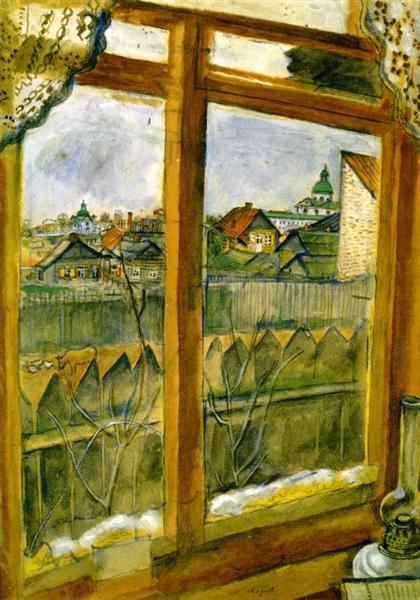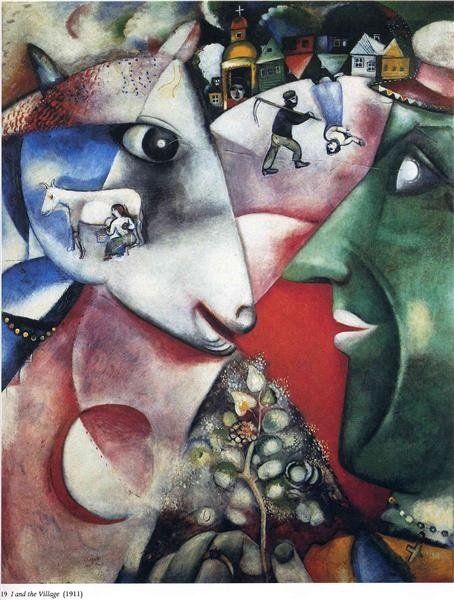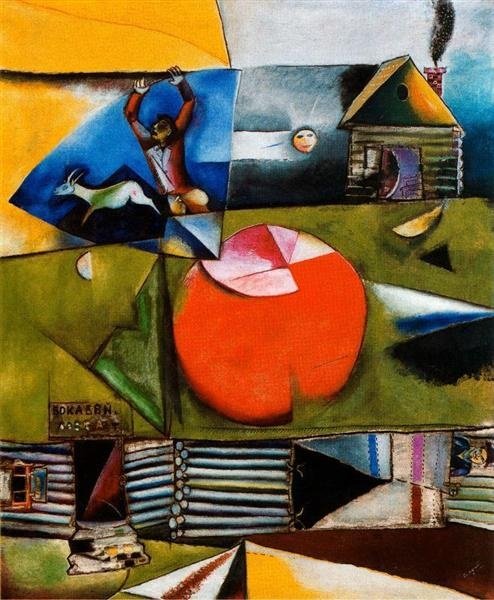Marc Chagall: pintura hecha de poesía | Marc Chagall: painting made of poetry
Marc Chagall es uno de esos artistas que han signado el desarrollo de la pintura contemporánea con su creación tan singular. Nacido el 7 de julio de 1887 en un pueblito –Vítebsk– de la actual Bielorrusia, su pertenencia a una familia judía marcó su vida en todos los sentidos. Fue un disidente de la Revolución rusa (a la que en un principio apoyó) y una víctima del acoso nazi. Por ello escapó primero a Francia y luego a los Estados Unidos.
============
Marc Chagall** is one of those artists who have marked the development of contemporary painting with his unique creations. Born on July 7, 1887 in a small town -Vitebsk- in present-day Belarus, his belonging to a Jewish family marked his life in every way. He was a dissident of the Russian Revolution (which he initially supported) and a victim of Nazi harassment. For this reason he escaped first to France and then to the United States.

Fuente | Source - Dominio público | Public Domain
Su pintura ha sido asociada al Arte Naif o Primitivismo, en lo que hay mucho de cierto, pues fue una tendencia muy cultivada en Rusia desde finales del siglo XIX, y en su formación plástica seguramente fue su primer gran influencia. Potenciada luego por uno de sus admirados pintores, Paul Gaugin, entre otros. Además, habría que considerar la identificación que Chagall tuvo con la vida sencilla de su región (costumbres, lugares, personajes, iconos, etc.), que ocupó su imaginario artístico. Sin embargo, al entrar en contacto con los artistas europeos su obra adquirirá también la influencia vanguardista de las primeras décadas del siglo XX con Picasso, Delaunay, Miró, entre otros.
============
His painting has been associated with Naif Art or Primitivism, in which there is much truth, as it was a trend widely cultivated in Russia since the late nineteenth century, and in his plastic training was surely his first major influence. It was later strengthened by one of his admired painters, Paul Gaugin, among others. In addition, we should consider the identification that Chagall had with the simple life of his region (customs, places, characters, icons, etc.), which occupied his artistic imaginary. However, when he came into contact with european artists, his work would also acquire the avant-garde influence of the first decades of the 20th century with Picasso, Delaunay, Miró, among others.

Una mirada a su obra desde la poesía la encontrará muy presente en esa visión tan imaginaria y libre que la caracteriza en su recreación, por medio del color y las formas, que fusiona realidades, las transforma, las espiritualiza, hasta la magia (algo del “realismo mágico” latinoamericano podría sentirse identificado en sus pinturas) de personajes que levitan o vuelan.
Pero es que Chagall, quizás marginalmente, también hizo poesía escrita, es decir, poemas en letras, pues ya sus cuadros son poemas pintados. Aquí les traigo uno que ha sido difundido.
============
A look at his work from the point of view of poetry will find it very present in that imaginary and free vision that characterizes it in its recreation, through color and shapes, that fuses realities, transforms them, spiritualizes them, even the magic (something of Latin American "magic realism" could be identified in his paintings) of characters that levitate or fly.
But it is that Chagall, perhaps marginally, also made written poetry, that is to say, poems in letters, since his paintings are already painted poems. Here I bring you one that has been spread.

Sólo mío
Sólo es mío
el pueblo que está en mi alma.
Entro allí sin pasaporte
como en mi casa.
Él sabe mi tristeza
y mi soledad.
Él me depara el sueño
y me cubre con una piedra
perfumada.En mí florecen jardines.
Mis flores son inventadas.
Las calles me pertenecen
pero no hay casas;
fueron desde la niñez destruidas
Sus habitantes vagan por el aire
en busca de alojamiento.
Pero viven en mi alma.He ahí por qué sonrío
cuando mi sol apenas brilla,
o lloro
como leve lluvia en la noche.Hubo un tiempo en que yo tenía dos cabezas.
Hubo un tiempo en que mis dos rostros
se cubrían de un vapor enamorado
y se desvanecían como el perfume de una rosa.Hoy me parece
que aun cuando retrocedo
voy hacia adelante,
hacia un alto portal
detrás del cual se yerguen los muros
donde duermen truenos extinguidos
y relámpagos plegados.Sólo es mío
el pueblo que está en mi alma.

It is only mine
It is only mine
the town that is in my soul.
I enter there without a passport
as in my home.
He knows my sadness
and my loneliness.
He gives me sleep
and covers me with a perfumed
scented stone.Gardens bloom in me.
My flowers are invented.
The streets belong to me
but there are no houses;
They have been destroyed since childhood
Their inhabitants wander through the air
in search of lodging.
But they live in my soul.That's why I smile
when my sun is barely shining,
or I cry
like light rain in the night.There was a time when I had two heads.
There was a time when my two faces
were covered with an enamored vapor
and faded like the perfume of a rose.Today it seems to me
that even when I go backwards
I go forward,
towards a high portal
behind which stand the walls
where extinguished thunder sleeps
and folded lightning.It is only mine
the people in my soul.
***
En este sencillo y conmovedor poema resalta esa pasión nunca perdida por su origen, por su pueblo, lo que hace desde un ánimo tocado por la nostalgia, el dolor y el amor. Posee elocuentes imágenes de la desgracia o el éxodo vivido por sus paisanos, en primer lugar por las calamidades del régimen soviético, y luego por la razia nazi.
En su pintura hizo toda una reelaboración imaginista de su pueblo, y aquí lo confirma: “Sus habitantes vagan por el aire / en busca de alojamiento. / Pero viven en mi alma.”
===
In this simple and moving poem he highlights that never lost passion for his origin, for his people, which he does from a mood touched by nostalgia, pain and love. He has eloquent images of the misfortune or exodus experienced by his countrymen, firstly because of the calamities of the Soviet regime, and then because of the Nazi raid.
In his painting he made a whole imagist reworking of his people, and here he confirms it: "Its inhabitants wander through the air / in search of lodging. / But they live in my soul."
Referencias /References:
https://es.wikipedia.org/wiki/Marc_Chagall
https://en.wikipedia.org/wiki/Marc_Chagall
https://www.wikiart.org/es/artists-by-art-movement/arte-naif-primitivismo
https://www.wikiart.org/en/artists-by-art-movement/na-ve-art-primitivism
http://letras-uruguay.espaciolatino.com/e/chagall_marc/solo_es_mio.htm

Gracias por su lectura | Thank you for reading.



https://twitter.com/jorma08/status/1545235795103162370
The rewards earned on this comment will go directly to the people( @josemalavem ) sharing the post on Twitter as long as they are registered with @poshtoken. Sign up at https://hiveposh.com.
Buen relato descriptivo y dialéctico del talento artístico de Marc Chagall.